
Climbing is the activity of using one's hands, feet, or any other part of the body to ascend a steep topographical object. It is done for locomotion, recreation and competition, and within trades that rely on ascension; such as emergency rescue and military operations. It is done indoors and out, on natural and man-made structures.
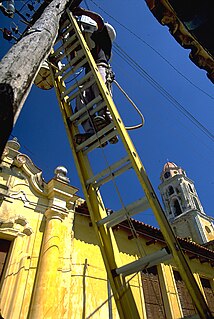
A ladder is a vertical or inclined set of rungs or steps.

A beehive is an enclosed structure in which some honey bee species of the subgenus Apis live and raise their young. Though the word beehive is commonly used to describe the nest of any bee colony, scientific and professional literature distinguishes nest from hive. Nest is used to discuss colonies that house themselves in natural or artificial cavities or are hanging and exposed. Hive is used to describe an artificial/man-made structure to house a honey bee nest. Several species of Apis live in colonies, but for honey production the western honey bee and the eastern honey bee are the main species kept in hives.

Outdoor cooking is the preparation of food in the outdoors. A significant body of techniques and specialized equipment exists for it, traditionally associated with nomadic cultures such as the Berbers of North Africa, the Arab Bedouins, the Plains Indians, pioneers in North America, and indigenous tribes in South America. These methods have been refined in modern times for use during recreational outdoors pursuits, by campers and backpackers.
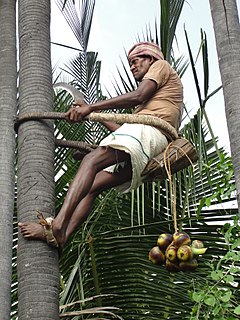
Tree climbing is a recreational or functional activity consisting of ascending and moving around in the crown of trees.
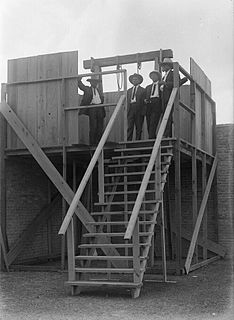
A gallows is a frame or elevated beam, typically wooden, from which objects can be suspended or "weighed". Gallows were thus widely used to suspend public weighing scales for large and heavy objects such as sacks of grain or minerals, usually positioned in markets or toll gates. The term was also used for a projecting framework from which a ship's anchor might be raised so that it is no longer sitting on the bottom, i.e., "weighing [the] anchor,” while avoiding striking the ship’s hull.

A swing is a seat, often found at playgrounds for children, at a circus for acrobats, or on a porch for relaxing, although they may also be items of indoor furniture, such as the Latin American hammock or the Indian oonjal. The seat of a swing may be suspended from chains or ropes. Once a swing is in motion, it continues to oscillate like a pendulum until external interference or drag brings it to a halt. Swing sets are very popular with children.
In rock climbing and ice climbing, a pitch is a steep section of a route that requires a rope between two belays, as part of a climbing system. Standard climbing ropes are between 50 and 80 metres long, so a pitch is always shorter, between two convenient ledges if possible; longer routes are multi-pitch, requiring the re-use of the rope each time. In free climbing, pitch refers to classification by climbers of the difficulty of ascent on certain climbing routes.
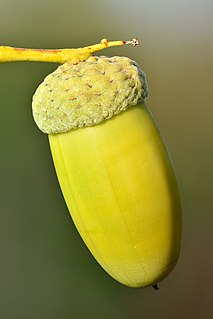
The acorn, or oaknut, is the nut of the oaks and their close relatives. It usually contains one seed, enclosed in a tough, leathery shell, and borne in a cup-shaped cupule. Acorns are 1–6 cm long and 0.8–4 cm on the fat side. Acorns take between 6 and 24 months to mature; see the list of Quercus species for details of oak classification, in which acorn morphology and phenology are important factors.
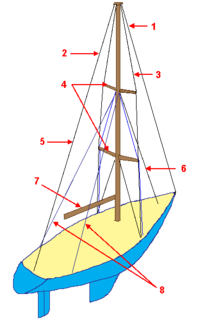
A guy-wire, guy-line, guy-rope, or stay, also called simply a guy, is a tensioned cable designed to add stability to a free-standing structure. They are used commonly for ship masts, radio masts, wind turbines, utility poles, and tents. A thin vertical mast supported by guy wires is called a guyed mast. Structures that support antennas are frequently of a lattice construction and are called "towers". One end of the guy is attached to the structure, and the other is anchored to the ground at some distance from the mast or tower base. The tension in the diagonal guy-wire, combined with the compression and buckling strength of the structure, allows the structure to withstand lateral loads such as wind or the weight of cantilevered structures. They are installed radially, usually at equal angles about the structure, in trios and quads. As the tower leans a bit due to the wind force, the increased guy tension is resolved into a compression force in the tower or mast and a lateral force that resists the wind load. For example, antenna masts are often held up by three guy-wires at 120° angles. Structures with predictable lateral loads, such as electrical utility poles, may require only a single guy-wire to offset the lateral pull of the electrical wires, at a spot where the wires change direction.
This is a glossary of firefighting equipment.

Hoarding or caching in animal behavior is the storage of food in locations hidden from the sight of both conspecifics and members of other species. Most commonly, the function of hoarding or caching is to store food in times of surplus for times when food is less plentiful. However, there is evidence that some amount of caching or hoarding is done in order to ripen the food, called ripening caching. The term hoarding is most typically used for rodents, whereas caching is more commonly used in reference to birds, but the behaviors in both animal groups are quite similar.

A toolbox is a box to organize, carry, and protect the owner's tools. They could be used for trade, a hobby or DIY, and their contents vary with the craft.
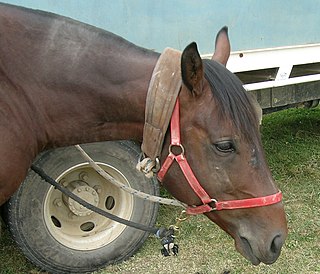
An animal collar is a device that attaches to the neck of an animal to allow it to be harnessed or restrained.

Outdoor recreation, such as hiking, camping, canoeing, cycling, or skiing, entails risks, even if participants do not recklessly place themselves in harm's way. In some circumstances, such as being in remote locations or in extreme weather conditions, even a minor accident may create a dangerous situation that requires survival skills. However, with correct precautions, even fairly adventurous outdoor recreation can be enjoyable and safe.

Bear-resistant food storage containers, also called bear canisters or bear cans, are usually hard-sided containers used by backpackers to protect their food from theft by bears. Bear canisters are seeing increased popularity in areas where bears have become habituated to human presence, and are required in some places, such as Yosemite National Park in the United States.
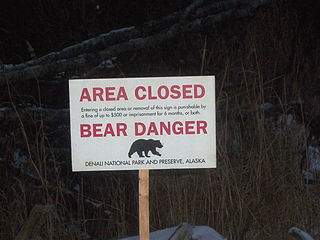
Bear danger is the risk encountered by humans and their pets or livestock when interacting with bears.

The food of the Tlingit people, an indigenous people from Alaska, British Columbia, and the Yukon, is a central part of Tlingit culture, and the land is an abundant provider. A saying amongst the Tlingit is that "When the tide goes out the table is set." This refers to the richness of intertidal life found on the beaches of Southeast Alaska, most of which can be harvested for food. Another saying is that "in Lingít Aaní you have to be an idiot to starve". Since food is so easy to gather from the beaches, a person who cannot feed himself at least enough to stay alive is considered a fool, perhaps mentally incompetent or suffering from very bad luck. Though eating off the beach could provide a fairly healthy and varied diet, eating nothing but "beach food" is considered contemptible among the Tlingit, and a sign of poverty. Shamans and their families were required to abstain from all food gathered from the beach, and men might avoid eating beach food before battles or strenuous activities in the belief that it would weaken them spiritually and perhaps physically as well. Thus for both spiritual reasons as well as to add some variety to the diet, the Tlingit harvest many other resources for food besides what they easily find outside their front doors. No other food resource receives as much emphasis as salmon; however, seal and game are both close seconds.
Tree stands or deer stands are open or enclosed platforms used by hunters. The platforms are secured to trees in order to elevate the hunter and give them a better vantage point. A tripod stand is a similar device, but because it is freestanding rather than attached to a tree, it is not technically a tree stand.

A container is any receptacle or enclosure for holding a product used in storage, packaging, and transportation, including shipping. Things kept inside of a container are protected on several sides by being inside of its structure. The term is most frequently applied to devices made from materials that are durable and are often partly or completely rigid.






















